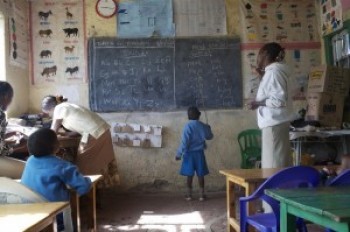World AIDS Day reflections: Living beyond AIDS
World AIDS Day reflections: Living beyond AIDS
This week, I received a very heartening piece of news: Cyrus, one of the first orphans we met in Kenya some 10 years ago, is heading to the University of Nairobi to study biochemistry with an eye to becoming a doctor. This is a striking development, given Cyrus’ history; at age 8, he was reduced to roaming the hardscrabble streets of Naivasha, Kenya after his mother disappeared. Tragically, she was later found in a pile of bodies in the local morgue, yet another victim of AIDS.
The news of Cyrus arrived on the eve of World AIDS Day, that time of year when I stop to reflect on the epidemic and its impact on the daily lives of people in Africa. Fortunately, UNAIDS offered some good news in its annual report (.pdf). Some 6.6 million people worldwide, the majority of them in sub-Saharan Africa, now have access to antiretroviral medications. That’s major progress; when Cyrus’ mother was suffering, these drugs were virtually unheard of in Africa. The availability of medication has led to a decline in deaths, with 1.8 million felled by AIDS in 2010, compared to a high of 2.2 million a year in the mid-2000s, according to UNAIDS.
Still, the virus continues to spread, despite an uptick in prevention and awareness. The number of newly infected people stood at 2.7 million in 2010, the same as the previous year. That’s about twice the number of people getting access to drugs for the first time, UNAIDS reported.
So we are still one step behind in controlling the epidemic. And the global economic crisis is affecting progress. The Global Fund to Fight AIDS, TB and Malaria – the largest single source of HIV funding and the largest provider of medication – recently said it would postpone its next round of grants because of reduced contributions from the rich countries of the West. Some predict that could have dire consequences for those in southern Africa, adding to the suffering and death.
Recently, Secretary of State Hillary Clinton provided an upbeat perspective on the epidemic with her vision for an “AIDS-free generation.” She noted that the science is there to stop AIDS – that it’s matter of translating the science into active interventions.
That’s why I cling to Cyrus’ example. He and his brother were alone in the world after his mother’s death. Their plight sparked some local activists to build two model children’s shelters in Kenya, funded in part by private individuals abroad. With nurturing, support and education, Cyrus has grown into a very capable young man. That kind of model could be adapted to African communities in general; with continued nurturing and support from abroad and within, Africans can rebuild their lives and move beyond the catastrophe of AIDS.
By Ruthann Richter
Stanford University Medical Center
Photo by Karen Ande
###
* Stanford University Medical Center integrates research, medical education and patient care at its three institutions – Stanford University School of Medicine, Stanford Hospital & Clinics and Lucile Packard Children’s Hospital.
** The above story is adapted from materials provided by Stanford University School of Medicine
________________________________________________________________




















